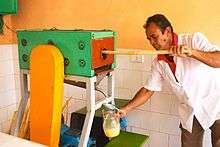Sugarcane juice


Sugarcane juice is the syrup extracted from pressed sugarcane. "Juice" is misleading as this is not a fruit or vegetable juice.[1] It is consumed as a beverage in many places, especially where sugarcane is commercially grown such as Southeast Asia, the Indian Subcontinent, Egypt, and Latin America. Evaporated cane juice, as an ingredient in prepared food, is a misleading way of saying "sugar".[2]
Sugarcane juice is obtained by crushing peeled sugar cane in a mill and is one of the main precursors of rum.
Health risks
Raw sugar cane juice can be a health risk to drinkers due to the unhygienic conditions under which it is prepared. There are some diseases that can be transmitted by raw sugar-cane, such as Leptospirosis.[3] In Brazil, sugarcane juice has been linked to cases of Chagas disease, as sugarcane can contain traces of its responsible pathogen, Trypanosoma cruzi, left by infected bugs if not properly cleaned.[4]
"Evaporated cane juice"
Evaporated cane juice is a misleading term for "sugar". Sugar can include glucose or fructose. Sugar is a partially purified sugar syrup, produced from a single-crystallization process during sugar cane milling.
The US Food and Drug Administration (FDA) defines evaporated cane juice as any sweetener derived from sugarcane syrup. The US FDA considers the term “evaporated cane juice” to be misleading because the term incorrectly suggests that it is a juice, when it is sugar syrup. Instead, the US FDA recommends using “sugar cane syrup” or “dried cane syrup” on food labels.[2]
Regions
Asia
Indonesia
In Indonesia, sugarcane juice drink is called minuman sari tebu. The iced sugar cane juice is called es tebu.[5] In Indonesian, tebu is sugarcane and es is ice. It is one of traditional drink commonly sold on street-side in Indonesia.[6] The sugarcane plant has been cultivated in Java since ancient times. The earliest record came from a 9th-century inscription dated from Medang Mataram period that describes a sweet drink called Nalaka Rasa which translate as sugarcane juice.[7]
The sugarcane is extracted using pressing machine to squeeze the sugary sap from sugarcane. The machine might be manually man-powered, fueled with gasoline, or electric-powered.[8] The juice sold there are always served cold with ice cubes. Traditionally, it is sold throughout the country especially among street vendors that set their stall on the street side. However, today sugarcane drink vendors with much improved hygiene, can also be found in foodcourts in malls and shopping centers.[9]
Vietnam
Sugarcane juice, called nước mía or mía đá, is very popular in Vietnam as a refreshing drink in the hot climate. Kumquat juice, a citrus, is often added to balance the sweetness.[10] It is available at small street stalls and is often sold alongside other popular Asian beverages. It was common for sugarcane juice to be sold in small plastic bags filled with ice, with the open end attached around a drinking straw by a rubber band. It is now more commonly sold in disposable plastic cups.[11]
Africa
Sugarcane juice is also a refreshing drink in Africa
Madagascar
In the eastern region of Madagascar, sugarcane juice is fermented to make an inexpensive alcoholic beverage called betsa-betsa. The drink is popular with locals because it is cheaper than beer.[12]
See also
References
- ↑ Nutrition, Center for Food Safety and Applied. "Constituent Updates - FDA Releases Final Guidance Regarding the Food Labeling Term "Evaporated Cane Juice"". www.fda.gov. Retrieved 2017-09-14.
- 1 2 "DRAFT Guidance for Industry: Ingredients Declared as Evaporated Cane Juice; Draft Guidance", Food and Drug Administration, October 2009.
Joe Satran, "Trader Joe's Lawsuit Over 'Evaporated Cane Juice' Part of Firm's Crusade Against Mislabeled Foods", The Huffington Post, 29 March 2013.
- ↑ https://www.business.qld.gov.au/industry/agriculture/species/diseases-disorders/animals/leptospirosis
- ↑ http://www.fiocruz.br/chagas/cgi/cgilua.exe/sys/start.htm?sid=11
- ↑ "Kisah di Balik Segarnya Minuman Es Tebu". CNN Indonesia (in Indonesian). Retrieved 2017-11-15.
- ↑ W, Rian Yulianto. Minuman Tradisional Indonesia (in Indonesian). Gulajava Ministudio. p. 36.
- ↑ Widjanarko, Tulus. "Hanya Ada Di Candi Sojiwan: Menu Hidangan Raja Mataram Kuno". Tempo (in Indonesian). Retrieved 2017-11-15.
- ↑ "MESIN PEMBUAT ES TEBU / SUGAR CANE EXTRACTOR Indonesia | HARMESINDO". www.harmesindo.com (in Indonesian). Retrieved 2017-11-15.
- ↑ Mediatama, Grahanusa. "Menyedot laba manis minuman tebu". kontan.co.id (in Indonesian). Retrieved 2017-11-15.
- ↑ "Sweetest at the throat". March 30, 2010. Retrieved November 7, 2011.
- ↑ "Nuoc mia, or sugar-cane juice". November 6, 2008. Retrieved November 7, 2011.
- ↑ Bradt, Hilary; Austin, Daniel (1 July 2014). "Madagascar". Bradt Travel Guides – via Google Books.
